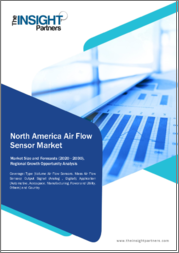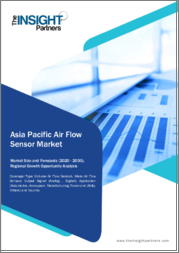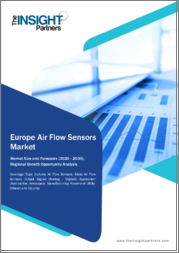
|
시장보고서
상품코드
1574021
냉각수 유량 센서 시장 : 유형, 용도, 최종사용자 산업, 조직 규모별 - 세계 예측(2025-2030년)Coolant Flow Sensor Market by Type (Magnetic Inductive Flow Sensor, Ultrasonic Flow Sensor, Vortex Flow Sensor), Application (Automotive, Industrial Equipment, Power Generation), End-User Industry, Organization Size - Global Forecast 2025-2030 |
||||||
냉각수 유량 센서 세계 시장 규모는 2023년 5억 2,113만 달러로 2024년에는 5억 4,818만 달러에 달할 것으로 예상되며, 연평균 5.33% 성장하여 2030년에는 7억 4,972만 달러에 달할 것으로 예상됩니다.
냉각수 유량 센서 세계 시장은 자동차 및 산업용 엔진의 냉각수 흐름을 모니터링하여 최적의 온도 조절을 보장하고 과열을 방지하는 중요한 역할로 정의됩니다. 이러한 필요성은 배기가스 배출에 대한 엄격한 환경 규제 속에서 자동차의 효율성, 내구성 및 성능 향상에 대한 중요성이 강조되고 있기 때문입니다. 최종 용도는 엔진의 열 안정성을 유지하는 것이 중요한 자동차, 항공우주, 해양, 중장비 산업 등 다양한 분야에 걸쳐 있습니다. 시장 인사이트에 따르면 전기자동차와 하이브리드 자동차의 보급이 주요 성장 요인이며, 이러한 자동차는 복잡한 냉각 시스템이 필요하고 그 결과 더 많은 센서가 필요합니다. 또한 IoT 및 AI 통합과 같은 센서 기술의 발전은 센서의 정확성, 자가 진단 기능 및 연결성을 향상시킬 수 있는 잠재적 기회를 제공합니다. 이러한 기회를 포착하기 위해 기업은 스마트 센서와 예지보전 솔루션에 초점을 맞춘 연구개발에 투자해야 합니다. 그러나 높은 초기 비용, 기존 시스템의 개조 복잡성, 열악한 환경 조건으로 인한 센서의 지연 및 부정확성 문제 등이 시장 성장을 저해하는 요인으로 작용할 수 있습니다. 빠른 기술 발전을 특징으로 하는 시장 경쟁은 기술 혁신에 대한 민첩한 접근 방식을 필요로 합니다. 기업들은 다기능 센서 개발과 소형화 기술 강화에 집중함으로써 사업 성장을 이룰 수 있습니다. 이러한 기술은 자동차의 소형화 및 첨단화 추세에 따라 매우 중요합니다. 또한, 자동차 제조사와의 전략적 파트너십과 신흥 시장에 대한 투자는 시장 확대의 새로운 길을 열어줄 수 있습니다. 이러한 과제를 해결하고 혁신을 활용함으로써 기업들은 세계 냉각수 유량 센서 시장에서 확고한 발판을 마련할 수 있습니다. 전반적으로 이 시장은 보다 스마트하고 효율적인 시스템으로 나아가는 추세를 보이고 있으며, 기술 발전과 혁신적인 솔루션에 대한 큰 잠재력을 가지고 있습니다.
| 주요 시장 통계 | |
|---|---|
| 기준 연도[2023] | 5억 2,113만 달러 |
| 예측 연도[2024] | 5억 4,818만 달러 |
| 예측 연도[2030] | 7억 4,972만 달러 |
| CAGR(%) | 5.33% |
시장 역학 : 빠르게 진화하는 냉각수 유량 센서 세계 시장 주요 시장 인사이트 공개
냉각수 유량 센서 세계 시장은 수요와 공급의 역동적인 상호 작용으로 인해 변화하고 있습니다. 이러한 시장 역학의 변화를 이해함으로써 기업은 정보에 입각한 투자 결정, 전략적 의사결정, 새로운 비즈니스 기회를 포착할 수 있습니다. 이러한 트렌드를 종합적으로 파악함으로써 기업은 정치적, 지리적, 기술적, 사회적, 경제적 영역에 걸친 다양한 리스크를 완화하고, 소비자 행동과 그것이 제조 비용 및 구매 동향에 미치는 영향을 보다 명확하게 이해할 수 있습니다.
- 시장 촉진요인
- 산업 기계 및 장비에서 냉각수 유량 센서 사용 증가
- 자동차의 성능과 효율성에 대한 소비자 및 규제 당국의 관심 증가
- 시장 억제요인
- 냉각수 유량 센서의 통합 및 유지보수 복잡성
- 시장 기회
- 의료기기 및 실험실 장비에서 냉각수 유량 센서의 세계 사용 확대
- IoT 시스템 및 스마트 자동차 기술에 대한 센서 통합
- 시장 과제
- 다양한 환경 조건에서 정확성과 신뢰성 보장
Porter's Five Forces: 절삭유 유량 센서 세계 시장 공략을 위한 전략적 도구
"Porter's Five Forces" 프레임워크는 시장 상황의 경쟁 상황을 파악하는 중요한 도구입니다. Porter's Five Forces 프레임워크는 기업의 경쟁력을 평가하고 전략적 기회를 탐색할 수 있는 명확한 방법을 제공합니다. 이 프레임워크는 기업이 시장 내 세력도를 평가하고 신규 사업의 수익성을 판단하는 데 도움이 됩니다. 이러한 인사이트를 통해 기업은 강점을 활용하고, 약점을 해결하고, 잠재적인 도전을 피하고, 보다 강력한 시장 포지셔닝을 확보할 수 있습니다.
PESTLE 분석 : 냉각수 유량 센서 세계 시장에서 외부 영향 파악
외부 거시 환경 요인은 냉각수 유량 센서 세계 시장 성과 역학을 형성하는 데 매우 중요한 역할을 합니다. 정치적, 경제적, 사회적, 기술적, 법적, 환경적 요인에 대한 분석은 이러한 영향을 탐색하는 데 필요한 정보를 제공하며, PESTLE 요인을 조사함으로써 기업은 잠재적 위험과 기회를 더 잘 이해할 수 있습니다. 이러한 분석을 통해 기업은 규제, 소비자 선호도, 경제 동향의 변화를 예측하고 선제적이고 적극적인 의사결정을 내릴 준비를 할 수 있습니다.
시장 점유율 분석 : 냉각수 유량 센서 세계 시장 경쟁 상황 파악
냉각수 유량 센서 세계 시장 점유율에 대한 상세한 시장 점유율 분석을 통해 공급업체의 성과를 종합적으로 평가할 수 있습니다. 기업은 수익, 고객 기반, 성장률과 같은 주요 지표를 비교하여 경쟁적 위치를 파악할 수 있습니다. 이 분석은 시장의 집중화, 단편화 및 통합 추세를 파악할 수 있으며, 공급업체는 치열한 경쟁 속에서 자신의 입지를 강화할 수 있는 전략적 의사결정을 내리는 데 필요한 인사이트를 얻을 수 있습니다.
FPNV 포지셔닝 매트릭스 : 절삭유 유량 센서 세계 시장에서의 벤더 성능 평가
FPNV 포지셔닝 매트릭스는 세계 절삭유 유량 센서 시장에서 벤더를 평가할 수 있는 중요한 도구입니다. 이 매트릭스를 통해 비즈니스 조직은 벤더의 비즈니스 전략과 제품 만족도를 기반으로 평가하여 목표에 부합하는 정보에 입각한 의사결정을 내릴 수 있으며, 4개의 사분면으로 벤더를 명확하고 정확하게 세분화하여 전략 목표에 가장 적합한 파트너와 솔루션을 식별할 수 있습니다. 전략 목표에 가장 적합한 파트너와 솔루션을 식별할 수 있습니다.
전략 분석 및 권장 절삭유 유량 센서 세계 시장에서의 성공을 위한 전략 분석 및 권장 사항
냉각수 유량 센서 세계 시장 전략 분석은 세계 시장에서의 입지를 강화하고자 하는 기업에게 필수적입니다. 주요 자원, 역량 및 성과 지표를 검토함으로써 기업은 성장 기회를 식별하고 개선할 수 있습니다. 이러한 접근 방식을 통해 경쟁 환경의 도전을 극복하고 새로운 비즈니스 기회를 활용하여 장기적인 성공을 거둘 수 있도록 준비할 수 있습니다.
이 보고서는 주요 관심 분야를 포괄하는 시장에 대한 종합적인 분석을 제공합니다.
1. 시장 침투도: 현재 시장 환경의 상세한 검토, 주요 기업의 광범위한 데이터, 시장 도달 범위 및 전반적인 영향력 평가.
2. 시장 개척도: 신흥 시장에서의 성장 기회를 파악하고, 기존 분야의 확장 가능성을 평가하며, 미래 성장을 위한 전략적 로드맵을 제공합니다.
3. 시장 다각화: 최근 제품 출시, 미개척 지역, 업계의 주요 발전, 시장을 형성하는 전략적 투자를 분석합니다.
4. 경쟁 평가 및 정보: 경쟁 상황을 철저히 분석하여 시장 점유율, 사업 전략, 제품 포트폴리오, 인증, 규제 당국의 승인, 특허 동향, 주요 기업의 기술 발전 등을 검토합니다.
5. 제품 개발 및 혁신: 향후 시장 성장을 촉진할 것으로 예상되는 첨단 기술, 연구 개발 활동 및 제품 혁신을 강조합니다.
이해관계자들이 충분한 정보를 바탕으로 의사결정을 내릴 수 있도록 다음과 같은 중요한 질문에 대한 답변도 제공합니다.
1. 현재 시장 규모와 향후 성장 전망은?
2. 최고의 투자 기회를 제공하는 제품, 부문, 지역은 어디인가?
3. 시장을 형성하는 주요 기술 동향과 규제의 영향은?
4. 주요 벤더의 시장 점유율과 경쟁 포지션은?
5. 벤더의 시장 진입 및 철수 전략의 원동력이 되는 수익원과 전략적 기회는 무엇인가?
목차
제1장 서문
제2장 조사 방법
제3장 주요 요약
제4장 시장 개요
제5장 시장 인사이트
- 시장 역학
- 성장 촉진요인
- 성장 억제요인
- 기회
- 과제
- 시장 세분화 분석
- Porter's Five Forces 분석
- PESTEL 분석
- 정치
- 경제
- 사회
- 기술
- 법률
- 환경
제6장 냉각수 유량 센서 세계 시장 : 유형별
- 자기유도식 유량 센서
- 초음파 유량 센서
- 와류 센서
제7장 냉각수 유량 센서 세계 시장 : 용도별
- 자동차
- 산업 기기
- 발전
제8장 냉각수 유량 센서 세계 시장 : 최종 이용 업계별
- 화학제품
- 석유 및 가스
제9장 냉각수 유량 센서 세계 시장 : 조직 규모별
- 대기업
- 중소기업
제10장 아메리카의 냉각수 유량 센서 세계 시장
- 아르헨티나
- 브라질
- 캐나다
- 멕시코
- 미국
제11장 아시아태평양의 냉각수 유량 센서 세계 시장
- 호주
- 중국
- 인도
- 인도네시아
- 일본
- 말레이시아
- 필리핀
- 싱가포르
- 한국
- 대만
- 태국
- 베트남
제12장 유럽, 중동 및 아프리카의 냉각수 유량 센서 세계 시장
- 덴마크
- 이집트
- 핀란드
- 프랑스
- 독일
- 이스라엘
- 이탈리아
- 네덜란드
- 나이지리아
- 노르웨이
- 폴란드
- 카타르
- 러시아
- 사우디아라비아
- 남아프리카공화국
- 스페인
- 스웨덴
- 스위스
- 터키
- 아랍에미리트
- 영국
제13장 경쟁 상황
- 시장 점유율 분석 2023
- FPNV 포지셔닝 매트릭스, 2023
- 경쟁 시나리오 분석
- 전략 분석과 제안
The Coolant Flow Sensor Market was valued at USD 521.13 million in 2023, expected to reach USD 548.18 million in 2024, and is projected to grow at a CAGR of 5.33%, to USD 749.72 million by 2030.
The coolant flow sensor market is defined by its essential role in monitoring the coolant flow within automotive and industrial engines to ensure optimal temperature regulation and prevent overheating. Its necessity stems from the growing emphasis on enhancing vehicle efficiency, durability, and performance, amidst stringent environmental regulations on emissions. The applications span a variety of end-use segments including automotive, aerospace, marine, and heavy machinery industries where maintaining engine thermal stability is crucial. Market insights reveal the increasing proliferation of electric and hybrid vehicles as a key growth influencer, as these vehicles require intricate cooling systems and, consequently, more sensors. Additionally, advancements in sensor technology, such as the integration of IoT and AI, present potential opportunities to increase sensor precision, self-diagnosis capabilities, and connectivity. To seize these opportunities, companies should invest in research and development focused on smart sensors and predictive maintenance solutions. However, challenges such as high initial costs, complexity in retrofitting existing systems, and issues with sensor lag or inaccuracy due to harsh environmental conditions can hinder market growth. The competitive nature of the market, characterized by rapid technological advancements, necessitates an agile approach to innovation. Companies can achieve business growth by focusing on developing multi-functional sensors and enhancing miniaturization techniques, which are crucial as vehicles become increasingly compact and tech-focused. Furthermore, strategic partnerships with vehicle manufacturers and investments in emerging markets can provide new avenues for market expansion. By addressing these challenges and capitalizing on innovations, businesses can establish a strong foothold in the coolant flow sensor market. Overall, the market demonstrates a progressive trend towards smarter, efficient systems, with significant potential for technological advancements and innovative solutions.
| KEY MARKET STATISTICS | |
|---|---|
| Base Year [2023] | USD 521.13 million |
| Estimated Year [2024] | USD 548.18 million |
| Forecast Year [2030] | USD 749.72 million |
| CAGR (%) | 5.33% |
Market Dynamics: Unveiling Key Market Insights in the Rapidly Evolving Coolant Flow Sensor Market
The Coolant Flow Sensor Market is undergoing transformative changes driven by a dynamic interplay of supply and demand factors. Understanding these evolving market dynamics prepares business organizations to make informed investment decisions, refine strategic decisions, and seize new opportunities. By gaining a comprehensive view of these trends, business organizations can mitigate various risks across political, geographic, technical, social, and economic domains while also gaining a clearer understanding of consumer behavior and its impact on manufacturing costs and purchasing trends.
- Market Drivers
- Increased use of coolant flow sensors in industrial machinery and equipment
- Growing consumer and regulatory focus on vehicle performance and efficiency
- Market Restraints
- Complexity involved in the integration and maintenance of coolant flow sensors
- Market Opportunities
- Expanding use of coolant flow sensor in medical and laboratory equipments
- Integration of sensors into IoT systems and smart vehicle technologies
- Market Challenges
- Ensuring accuracy and reliablility in diverse environmental cnditions
Porter's Five Forces: A Strategic Tool for Navigating the Coolant Flow Sensor Market
Porter's five forces framework is a critical tool for understanding the competitive landscape of the Coolant Flow Sensor Market. It offers business organizations with a clear methodology for evaluating their competitive positioning and exploring strategic opportunities. This framework helps businesses assess the power dynamics within the market and determine the profitability of new ventures. With these insights, business organizations can leverage their strengths, address weaknesses, and avoid potential challenges, ensuring a more resilient market positioning.
PESTLE Analysis: Navigating External Influences in the Coolant Flow Sensor Market
External macro-environmental factors play a pivotal role in shaping the performance dynamics of the Coolant Flow Sensor Market. Political, Economic, Social, Technological, Legal, and Environmental factors analysis provides the necessary information to navigate these influences. By examining PESTLE factors, businesses can better understand potential risks and opportunities. This analysis enables business organizations to anticipate changes in regulations, consumer preferences, and economic trends, ensuring they are prepared to make proactive, forward-thinking decisions.
Market Share Analysis: Understanding the Competitive Landscape in the Coolant Flow Sensor Market
A detailed market share analysis in the Coolant Flow Sensor Market provides a comprehensive assessment of vendors' performance. Companies can identify their competitive positioning by comparing key metrics, including revenue, customer base, and growth rates. This analysis highlights market concentration, fragmentation, and trends in consolidation, offering vendors the insights required to make strategic decisions that enhance their position in an increasingly competitive landscape.
FPNV Positioning Matrix: Evaluating Vendors' Performance in the Coolant Flow Sensor Market
The Forefront, Pathfinder, Niche, Vital (FPNV) Positioning Matrix is a critical tool for evaluating vendors within the Coolant Flow Sensor Market. This matrix enables business organizations to make well-informed decisions that align with their goals by assessing vendors based on their business strategy and product satisfaction. The four quadrants provide a clear and precise segmentation of vendors, helping users identify the right partners and solutions that best fit their strategic objectives.
Strategy Analysis & Recommendation: Charting a Path to Success in the Coolant Flow Sensor Market
A strategic analysis of the Coolant Flow Sensor Market is essential for businesses looking to strengthen their global market presence. By reviewing key resources, capabilities, and performance indicators, business organizations can identify growth opportunities and work toward improvement. This approach helps businesses navigate challenges in the competitive landscape and ensures they are well-positioned to capitalize on newer opportunities and drive long-term success.
Key Company Profiles
The report delves into recent significant developments in the Coolant Flow Sensor Market, highlighting leading vendors and their innovative profiles. These include ABB Ltd., Alicat Scientific, Inc., Azbil Corporation, Badger Meter, Inc., Baumer Group, Dwyer Instruments, Inc., Fuji Electric Co., Ltd., General Electric Company, Honeywell International Inc., ifm electronic gmbh, Keyence Corporation, Koolance, Inc., Krohne Messtechnik GmbH, Marposs S.p.A., OMEGA Engineering, Inc., Robert Bosch GmbH, Sensirion AG, SICK AG, TE Connectivity Ltd., Turck Inc., Valeo S.A., and Yokogawa Electric Corporation.
Market Segmentation & Coverage
This research report categorizes the Coolant Flow Sensor Market to forecast the revenues and analyze trends in each of the following sub-markets:
- Based on Type, market is studied across Magnetic Inductive Flow Sensor, Ultrasonic Flow Sensor, and Vortex Flow Sensor.
- Based on Application, market is studied across Automotive, Industrial Equipment, and Power Generation.
- Based on End-User Industry, market is studied across Chemical and Oil & Gas.
- Based on Organization Size, market is studied across Large Enterprises and Small & Medium Enterprises (SMEs).
- Based on Region, market is studied across Americas, Asia-Pacific, and Europe, Middle East & Africa. The Americas is further studied across Argentina, Brazil, Canada, Mexico, and United States. The United States is further studied across California, Florida, Illinois, New York, Ohio, Pennsylvania, and Texas. The Asia-Pacific is further studied across Australia, China, India, Indonesia, Japan, Malaysia, Philippines, Singapore, South Korea, Taiwan, Thailand, and Vietnam. The Europe, Middle East & Africa is further studied across Denmark, Egypt, Finland, France, Germany, Israel, Italy, Netherlands, Nigeria, Norway, Poland, Qatar, Russia, Saudi Arabia, South Africa, Spain, Sweden, Switzerland, Turkey, United Arab Emirates, and United Kingdom.
The report offers a comprehensive analysis of the market, covering key focus areas:
1. Market Penetration: A detailed review of the current market environment, including extensive data from top industry players, evaluating their market reach and overall influence.
2. Market Development: Identifies growth opportunities in emerging markets and assesses expansion potential in established sectors, providing a strategic roadmap for future growth.
3. Market Diversification: Analyzes recent product launches, untapped geographic regions, major industry advancements, and strategic investments reshaping the market.
4. Competitive Assessment & Intelligence: Provides a thorough analysis of the competitive landscape, examining market share, business strategies, product portfolios, certifications, regulatory approvals, patent trends, and technological advancements of key players.
5. Product Development & Innovation: Highlights cutting-edge technologies, R&D activities, and product innovations expected to drive future market growth.
The report also answers critical questions to aid stakeholders in making informed decisions:
1. What is the current market size, and what is the forecasted growth?
2. Which products, segments, and regions offer the best investment opportunities?
3. What are the key technology trends and regulatory influences shaping the market?
4. How do leading vendors rank in terms of market share and competitive positioning?
5. What revenue sources and strategic opportunities drive vendors' market entry or exit strategies?
Table of Contents
1. Preface
- 1.1. Objectives of the Study
- 1.2. Market Segmentation & Coverage
- 1.3. Years Considered for the Study
- 1.4. Currency & Pricing
- 1.5. Language
- 1.6. Stakeholders
2. Research Methodology
- 2.1. Define: Research Objective
- 2.2. Determine: Research Design
- 2.3. Prepare: Research Instrument
- 2.4. Collect: Data Source
- 2.5. Analyze: Data Interpretation
- 2.6. Formulate: Data Verification
- 2.7. Publish: Research Report
- 2.8. Repeat: Report Update
3. Executive Summary
4. Market Overview
5. Market Insights
- 5.1. Market Dynamics
- 5.1.1. Drivers
- 5.1.1.1. Increased use of coolant flow sensors in industrial machinery and equipment
- 5.1.1.2. Growing consumer and regulatory focus on vehicle performance and efficiency
- 5.1.2. Restraints
- 5.1.2.1. Complexity involved in the integration and maintenance of coolant flow sensors
- 5.1.3. Opportunities
- 5.1.3.1. Expanding use of coolant flow sensor in medical and laboratory equipments
- 5.1.3.2. Integration of sensors into IoT systems and smart vehicle technologies
- 5.1.4. Challenges
- 5.1.4.1. Ensuring accuracy and reliablility in diverse environmental cnditions
- 5.1.1. Drivers
- 5.2. Market Segmentation Analysis
- 5.2.1. Application: Usage of coolant flow sensors in industrial equipment sector to maintain appropriate temperature and fluid levels
- 5.2.2. Type: Rising adoption of ultrasonic flow sensors to eliminate risk of contamination and pressure losses
- 5.3. Porter's Five Forces Analysis
- 5.3.1. Threat of New Entrants
- 5.3.2. Threat of Substitutes
- 5.3.3. Bargaining Power of Customers
- 5.3.4. Bargaining Power of Suppliers
- 5.3.5. Industry Rivalry
- 5.4. PESTLE Analysis
- 5.4.1. Political
- 5.4.2. Economic
- 5.4.3. Social
- 5.4.4. Technological
- 5.4.5. Legal
- 5.4.6. Environmental
6. Coolant Flow Sensor Market, by Type
- 6.1. Introduction
- 6.2. Magnetic Inductive Flow Sensor
- 6.3. Ultrasonic Flow Sensor
- 6.4. Vortex Flow Sensor
7. Coolant Flow Sensor Market, by Application
- 7.1. Introduction
- 7.2. Automotive
- 7.3. Industrial Equipment
- 7.4. Power Generation
8. Coolant Flow Sensor Market, by End-User Industry
- 8.1. Introduction
- 8.2. Chemical
- 8.3. Oil & Gas
9. Coolant Flow Sensor Market, by Organization Size
- 9.1. Introduction
- 9.2. Large Enterprises
- 9.3. Small & Medium Enterprises (SMEs)
10. Americas Coolant Flow Sensor Market
- 10.1. Introduction
- 10.2. Argentina
- 10.3. Brazil
- 10.4. Canada
- 10.5. Mexico
- 10.6. United States
11. Asia-Pacific Coolant Flow Sensor Market
- 11.1. Introduction
- 11.2. Australia
- 11.3. China
- 11.4. India
- 11.5. Indonesia
- 11.6. Japan
- 11.7. Malaysia
- 11.8. Philippines
- 11.9. Singapore
- 11.10. South Korea
- 11.11. Taiwan
- 11.12. Thailand
- 11.13. Vietnam
12. Europe, Middle East & Africa Coolant Flow Sensor Market
- 12.1. Introduction
- 12.2. Denmark
- 12.3. Egypt
- 12.4. Finland
- 12.5. France
- 12.6. Germany
- 12.7. Israel
- 12.8. Italy
- 12.9. Netherlands
- 12.10. Nigeria
- 12.11. Norway
- 12.12. Poland
- 12.13. Qatar
- 12.14. Russia
- 12.15. Saudi Arabia
- 12.16. South Africa
- 12.17. Spain
- 12.18. Sweden
- 12.19. Switzerland
- 12.20. Turkey
- 12.21. United Arab Emirates
- 12.22. United Kingdom
13. Competitive Landscape
- 13.1. Market Share Analysis, 2023
- 13.2. FPNV Positioning Matrix, 2023
- 13.3. Competitive Scenario Analysis
- 13.3.1. Turck unveils advanced flow sensors to enhance efficiency in monitoring
- 13.3.2. PSG launches enhanced flow sensor technology to optimize fluid management
- 13.4. Strategy Analysis & Recommendation
Companies Mentioned
- 1. ABB Ltd.
- 2. Alicat Scientific, Inc.
- 3. Azbil Corporation
- 4. Badger Meter, Inc.
- 5. Baumer Group
- 6. Dwyer Instruments, Inc.
- 7. Fuji Electric Co., Ltd.
- 8. General Electric Company
- 9. Honeywell International Inc.
- 10. ifm electronic gmbh
- 11. Keyence Corporation
- 12. Koolance, Inc.
- 13. Krohne Messtechnik GmbH
- 14. Marposs S.p.A.
- 15. OMEGA Engineering, Inc.
- 16. Robert Bosch GmbH
- 17. Sensirion AG
- 18. SICK AG
- 19. TE Connectivity Ltd.
- 20. Turck Inc.
- 21. Valeo S.A.
- 22. Yokogawa Electric Corporation



















